Webinar Highlights – Enable New LC/MS Users to Perform Routine Analyses of Protein with Confidence
Find out how to set up an efficient multi-user/multi-project walk-up solution for protein biochemistry
7 Jun 2018
LC/MS is widely used in the biopharmaceutical industry for confirmation of therapeutic protein molecular weights. It is a fast, accurate, and relatively quantitative technique.
In a recent SelectScience webinar, Thomas J. McLellan, senior scientist at Pfizer Inc., highlighted the establishment of a high-resolution/high mass accuracy walk-up solution, to provide intact mass analysis for protein biochemists. An overview of the hardware and software solutions was discussed, as well as how they were implemented to manage a multi-user environment.

This webinar explores:
- Implementation for users with multiple application projects
- Software applications to allow desktop access to data
- Analytical performance and system robustness
- Future expansion of methods and techniques
Read on for highlights from the Q&A session
Missed the webinar? Don’t worry, you can watch the webinar on-demand here >>
Q: Have you tried setting up alerts, for example emails or text messages, when there is a system error such as running out of solvent?
TM: We do have software set-up so that I get notice of when there is an error with the instrument and when someone is logged into the administration page. I can set up solvent alerts as well, however it is part of our daily process to check the instrument and solvent and re-calibrate it, so I didn’t think it was necessary to add alerts, but you certainly can do that.
Q: What would you like to see in the BioConfirm software so that non-MS expert users can trust post-translational modification (PTM) localization results from the MS/MS spectra?
TM: The software is designed to give you the most probable localization site, even if there is little or no information to suggest that that is the true localization of the PTM. It wants to tell you where your modification is, and it will tell you whether there is data supporting it or not. What I would love to see is that you could generate a confidence level for a localization such as a heat map where you could have green indicating a 90-100% confidence level for that localization, yellow for in between, and red where there is little or no data to support it. Right now, there is nothing to show them or give them any type of indication whether or not the localization is correct. We’ve made our reports and we have warning signs indicating that you cannot trust the software to give you the localization of your post-translation modification.
Q: Is there a glycoprotein specific method which can give me better sensitivity separations?
TM: I’m working on that currently and we’re collaborating with another academic lab that is generating column chemistry which is good at doing separations of glycoproteins. We’re trying to come up with a generic method that will enable us to do that, but at this time there is no way for us to do a glycoprotein separation which is compatible with the mass spec. We can do glycopeptides though which is just a typical digest experiment.
Q: How often are your non-MS users that access this system coming to you for help to interpret the data?
TM: I am answering questions to several people a day and always helping people with their data or helping them log into the instrument because they’re not doing it routinely. A lot of my routine users are running their samples and they are moving on to higher level questions, so they are moving forward in their education and how to interpret their data, so I’m always a resource to them. Most importantly, what I emphasize is if there is any question at all about your data, it is important to come talk to me and don’t go ahead and make an assumption.
Q: Have you implemented standard procedures to sample preparations to guide your users' appropriate sample conditions?
TM: The only thing we do is ask them to dilute their sample to 0.1 mg/ml in water prior to analysis. There is no standard protocol in preparation of their sample. But, we do ask if you know your sample has a bad detergent in it, please run a couple of blanks after your sample so the next person isn’t seeing that detergent in their results. For the digest portion, we do have a decision tree set up that helps them choose the protocol that will match their samples based on the concentration of the sample and what buffers are used.
Q: Can users select multiple automatic data processing methods for one sample?
TM: No, there is a standard one that is being generated for their sample. They would either have to create a method that is built into the method that they can select from, or they can go to the BioConfirm software, create any method that they would like to and reprocess their data and generate a report as well. I have some chemists who are running small molecules who complain the automatic data processing gives way too much data, so they go back and reprocess to give more precise and meaningful results.
Q: What is the sample complexity the system can tolerate, e.g. is there a maximum number of proteins that can be analyzed or how heterogenous can the protein PTM profile be in order to get meaningful results?
TM: We have had a protein where we knew it was degrading and we were able to determine about 36 different cleavage sites based on the number of proteins that we were able to see. I’m sure you can go to a much higher protein mix, I haven’t really tested that out. As far as PTMs, you want your sample to be as homogenous as possible, otherwise there are too many mathematical possibilities.
Watch the full webinar on demand here, or discover more exclusive SelectScience webinars.
Do you use any of the products mentioned in the article? Write a review today for your chance to win a $400 Amazon voucher.

